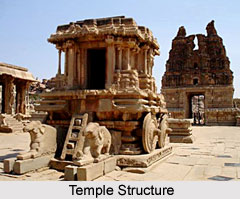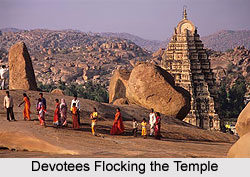 Virupaksha Temple is situated 350 km from Bengaluru in Hampi, in the Indian state of Karanataka which lies on the banks of the Tungabhadra River in the ancient Vijayanagara city. The evidences from the earlier scripture testify that the form of Virupaksha, also called Pampapati, was the principal deity of this site and the Virupaksha temple at Hampi was a place of pilgrimage and the most important temple of the area.
Virupaksha Temple is situated 350 km from Bengaluru in Hampi, in the Indian state of Karanataka which lies on the banks of the Tungabhadra River in the ancient Vijayanagara city. The evidences from the earlier scripture testify that the form of Virupaksha, also called Pampapati, was the principal deity of this site and the Virupaksha temple at Hampi was a place of pilgrimage and the most important temple of the area.
However, Virupaksha was not originally the main god of Hampi. Sites throughout southern India are associated with non-Aryan local goddesses, many of whom in course of time came to be `Sanskritized` by marriage to a great god of the Hindu pantheon, generally Lord Shiva. The original patron goddess of Hampi was Pampa indeed, the name Hampi is derived from Pampa, who is also known as Hampa-devi, and is considered as the `mind-born` daughter of Lord Brahma. As per legends the goddess performed severe penances in her quest to marry Virupaksha. Later she was reborn as Dakshayani, the daughter of Daksha. She again took birth as Parvati, the child of the Himalaya Mountains. From at least the Vijayanagara times to this day, the Kalyanotsava (marriage festival) of Virupaksha and Pampa has been the most important festival in the Virupaksha temple. Virupaksha is also known as Pampa-Virupaksha or as Pampapati, the husband of Pampa. Although this goddess in course of time became merely one of the two consorts of Virupaksha and her worship was relegated to only a small sub-shrine in the Virupaksha complex, her erstwhile importance is indicated by the fact that the site (Hampi), the river (Pampa) on which it is located, a lake (Pampa-sarovar), the principal male god (Pampapati) and even the entire pilgrimage area (Pampapura or Pampa-kshetra) still bear her name.
The cult of this goddess dates back to antiquity. She was probably an aquatic deity, hinted at by the fact that the Tungabhadra River at this site and a lake are also known by the name Pampa. The first specific reference to the goddess Pampa is in the inscription of 1199 in the Durga-devi shrine to the north of the Virupaksha temple.
The name Virupaksha, on the other hand, literally means Lord Shiva `with oblique eyes` or `of mis-formed eyes`. The division of the word `Virupaksha` goes like `vi + roop (mis-formed) + `aksha` (eye). Virupaksha is the lord of Hemakuta, the local hillock that is compared to the Himalayan Mountains in holiness and significance. The Virupaksha-linga on Hemakuta is included among the sixty-eight `svayambhii-lingas`, which are considered to be of special sanctity since they are self-manifest.
 The Virupaksha or the Pampapathi temple is the main centre of pilgrimage at Hampi. This temple is artistically structured and the towers of the temple deserve admiration. It dates back to the first half of the fifteenth century and was renovated in the sixteenth century by Krishnadevaraya. This tower has been built such that an inverted shadow of this huge tower falls on the western wall of the temple through a small hole behind the sanctum. The temple was expanded with many additions made to it of mandapas, sub-shrines, pillared galleries, and so on, so that from a small shrine it developed into an extensive temple complex. There is an ornate shrine to Bhuvaneswari and a shrine to Vidyaranya, the spiritual founder of Vijayanagara in this temple. The inner `prakaram` consists of shrines and pillars dating back to the 12th century.
The Virupaksha or the Pampapathi temple is the main centre of pilgrimage at Hampi. This temple is artistically structured and the towers of the temple deserve admiration. It dates back to the first half of the fifteenth century and was renovated in the sixteenth century by Krishnadevaraya. This tower has been built such that an inverted shadow of this huge tower falls on the western wall of the temple through a small hole behind the sanctum. The temple was expanded with many additions made to it of mandapas, sub-shrines, pillared galleries, and so on, so that from a small shrine it developed into an extensive temple complex. There is an ornate shrine to Bhuvaneswari and a shrine to Vidyaranya, the spiritual founder of Vijayanagara in this temple. The inner `prakaram` consists of shrines and pillars dating back to the 12th century.
Already in the late fourteenth or early fifteenth century, the original pre-Vijayanagaraa temple most probably have been enclosed by the building of a closed circumambulatory passage and one or more antechambers as well as an open, pillared passage on the three sides of the `vimana`. The closed `rangamandapa`, which has four doorways, was built before the sixteenth century. The granite portion of the northern gopura is also of the fifteenth century, for the flat pilasters on it are typical of the pre-sixteenth century `gopuras`. During the reign of Devaraya II, the Virupaksha temple was fairly large and elaborate and he added a `gopura` to the temple of Virupaksha at Hampi. Among the three `gopuras` namely a large outer eastern one, a small inner east and a northern one in Virupaksha temple, the inner east `gopura` was constructed by Krishnadevaraya, but the present outer east gate is, on stylistic grounds, evidently not a fifteenth-century structure. Therefore, by the early sixteenth century the Virupaksha temple was a large complex, comprising an outer and inner courtyard, three `gopuras`, pillared halls, a kitchen, galleries, a temple-tank, a chariot-street, the principal shrine and a number of sub-shrines.
Krishnadevaraya also built a `mandapam` in front of the sanctum, and embellished it with Vijayanagara style bas-reliefs and murals. Several of Shiva`s manifestations, and the ten incarnations of Lord Vishnu are portrayed here, as is the classic scene from Mahabharata depicting the shooting of Arjuna of the fish device in order to secure the hand of Draupadi for marriage. There is also a mural depicting Vidyaranya the spiritual founder of Vijayanagara in procession. In the vicinity of the Virupaksha temple are several dilapidated mandapams. In front of the temple was once an ancient shopping centre lined with mandapams, the ruins of which stand till date.
A Vijayanagara period Sanskrit language text, `Virupaksa-Vasantotsava-Campu` written by Ahobala, highlights the importance of god Virupaksha and the close association between the Vijayanagara king and this deity. The nine-day spring festival of Virupaksha described in this work is an elaborate and extensive affair, enacted under the patronage of the king of Vijayanagara Empire. The king of Vijayanagara plays a key role in the celebrations the festival is, therefore, a public display of imperial magnificence, linking both god Virupaksha and the king. By closely associating the two, this festival, this royal display, serves both to legitimize and consolidate the power of the king, who is the temporal embodiment of the power of the deity, and at the same time imbues and imparts to the deity a royal stature. The chariot festival in the month of February is the main annual festival celebrated here. The divine marriage between Virupaksheshwara and Pampa is celebrated in the month of December.
 The outstanding importance of Virupaksha during the Vijayanagara period is reflected in the setting up of temples dedicated to this god in other parts of the city and the kingdom. The earliest of these in the capital was the temple dedicated to Prasanna Virupaksha, also known as the `Underground Temple`. Another temple to Virupaksha was built in 1398 A.D. on Hemakuta hill by two Brahman brothers. Besides these two, on Hemakuta there is a small, pre-Vijayanagara shrine that is at present called the `Mula-Virupaksha Temple`.
The outstanding importance of Virupaksha during the Vijayanagara period is reflected in the setting up of temples dedicated to this god in other parts of the city and the kingdom. The earliest of these in the capital was the temple dedicated to Prasanna Virupaksha, also known as the `Underground Temple`. Another temple to Virupaksha was built in 1398 A.D. on Hemakuta hill by two Brahman brothers. Besides these two, on Hemakuta there is a small, pre-Vijayanagara shrine that is at present called the `Mula-Virupaksha Temple`.
In the nineteenth century the Virupaksha temple and cult seems to have been more active than in the previous century. Worship in the Virupaksha temple survived into the twentieth century. Thus, Virupaksha has been the principal deity of Hampi or Pampa-kshetra from at least the twelfth century AD to modern times. The great Virupaksha temple has been the most important temple at the site throughout these centuries, though it was temporarily overshadowed in splendour and popularity by the Vitthala temple for a few decades prior to AD 1565. The period of two hundred odd years that the site served as the capital of the greatest medieval Hindu kingdom in India was the peak period in the history of the Virupaksha temple and cult. During these years Virupaksha became the patron deity of a dynasty, a city and a kingdom, and his cult gained in immense prestige and popularity not only in Hampi, but also throughout the kingdom, manifested in generous endowments made to the great Virupaksha temple, grants issued in Virupaksha`s presence and temples to Virupaksha being constructed elsewhere in southern India. Yet god Virupaksha and his temple at Hampi were not dependent exclusively or even predominantly on royal patronage and connections, for they had enjoyed a following prior to the Vijayanagara period and have retained their significance long after the Vijayanagara kingdom has been relegated to the realm of history.
At present, the Virupaksha temple is the most important temple and pilgrimage spot in Hampi, drawing numerous devotees` daily and vast crowds for its principal festival.
The Virupaksha temple in Hampi stands as one of the major temples of the region and it has been carrying an age long history of architectural and sculptural construction that bedecked the temple and enhanced the historical importance of the temple.











